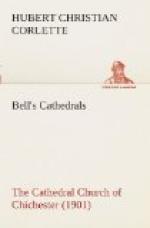The presence of this grouping of features is indicative of that influence which Continental architecture had exercised upon English art, and now that Norman government had been established that influence became more directly French. But though so strongly affected by this means, Anglo-Saxon character was always evident in work which was a native expression of the thought and personality of those by whom it was executed.
Thus we see that the plan which Ralph approved for the new church that was to be built for him at Chichester was devised according to accepted traditional arrangement. He adopted no new idea when he decided what general form the cathedral should follow. The disposition of the several parts differed in no wise from that which had been followed during centuries before. The requirements of ritual had decided long since what were those essential features of planning to be insisted upon, for the pattern in germ was shown in the arrangement of the Mosaic Tabernacle. In the earliest plans the same distribution of parts was observed, though at a later date the transept was introduced—an idea which no doubt had its origin in some practical necessity, and was afterwards retained as being representative of an ecclesiastical symbol.
Of the practical and artistic character of the architectural details we shall see more in examining the exterior and the interior of the church. These will lead us, of necessity, to deal more with archaeology in its relation to the history of architecture rather than of this particular church as a building used for ecclesiastical purposes.
After the ceremony of 1184 building operations were continued, but the records available do not tell about anything of much interest for the next two or three years. Then in 1186-1187 a catastrophe occurred—the cathedral was again burnt. But this time the effects of the fire were much more disastrous than had been the case in 1114. So extensive was the destruction that the entire roofing, as well as the internal flat ceiling, was gone; and though we can glean no certain knowledge from documentary evidence, it appears probable that the eastern section of the building suffered more than any other, for whatever other causes may have aided in the wreck of this part—a weakness in the masonry, an insufficiency in the supports or abutments—the fall of such heavy timbers as those which must have formed the outer roof and inner ceiling of the chancel would in itself be sufficient to wreck the remainder.
Whether the change in plan that now followed was really necessary because of the damage that had been done, or whether the fire provided a welcome opportunity by which new features might be introduced, we are not able to discover. It is sufficient that the chance was not lost, for in the eastern ambulatory of the cathedral church at Chichester is to be seen, as a result, one of the most truly beautiful examples of mediaeval design that English architecture now possesses.




